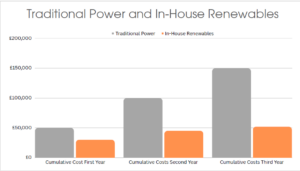This website uses cookies so that we can provide you with the best user experience possible. Cookie information is stored in your browser and performs functions such as recognising you when you return to our website and helping our team to understand which sections of the website you find most interesting and useful.
Why in-house renewable power generation will save you money in 2024
The environmental benefits of renewable power are well understood with 85% of people supporting its use on the national grid. However, many business owners and finance directors believe renewable power generation isn’t relevant to their business. Using in-house power generation methods, such as solar PV arrays or combined heat and power, is often dismissed as impractical, costly and unreliable.
These concerns lead many businesses to remain dependent on grid-supplied electricity or, at best, choose a renewable energy tariff from their regular supplier to help “green up” their energy supply. Contrary to these concerns, installing a renewable in-house power source will provide meaningful savings on energy bills compared to standard grid-supplied rates.
In-house energy production is totally reliable as it integrates seamlessly with the grid and can even provide an opportunity to make money by selling surplus generation back to the grid.
As we head into 2024, the time is right for businesses in all sectors to rethink their energy supply, be they manufacturing, processing, leisure or any function using electricity.
The Costs
The initial installation capex for on-site renewable electricity generation can deter many businesses from investing in the technology and selecting a renewable tariff from a grid supplier, which has almost no initial fees, can feel like the obvious choice for many business owners. However, traditional energy sources are more costly in the long term.
The current average price of grid-supplied electricity is about 27p per kilowatt-hour, and this cost has increased relentlessly year on year since the doldrum days of energy pricing pre-2010. In contrast, electricity generated in-house from solar PV typically costs about 7p per kilowatt-hour, and this provides a saving of up to 75% on a standard energy bill.

Beyond Costs
Another benefit to generating electricity in-house is the ability to feed power back to the grid. This process is known as “exporting” and refers to when a business’ on-site solar PV array produces more electricity than is required to supply the site’s loads.
A business can export excess power back to the grid and get paid for it. Whilst rates for exported power do fluctuate, it is possible to secure both average spot and long-term purchase contracts with your energy provider. Exporting surplus electricity further helps to offset system capex by generating additional revenue.
Reliability
A common concern with using renewable energy generated in-house is reliability. Yes, solar panels rely on UV light, and combined heat and power does need a use of the heat generated to make the maths work. However, the bulk of R&D resource into solar PV over recent years has developed panels that are so much more efficient at absorbing diffused UV light. This has led to greater outputs from modern solar PV arrays and the ability to install solar pv across a much wider range of orientations. In addition, it is the case that all solar PV arrays link seamlessly with grid-supplied power. At no point would a site lose its electricity supply because the sun went behind a cloud!
Clear Benefits of Solar PV:
- Cost-effective – ROIs for solar are typically in the range of 20- 30+%
- Solid green credentials
- Simple to install
- Cheap to maintain
- Longevity and warranties 25+ years
- No nuisance noise
- No exhaust gas emissions
Moving Forward:
The key message is don’t just sign up to a renewable energy contract with your regular electricity supplier. Yes, you will be able to demonstrate the carbon saving but it will cost you more, so don’t rely on others to put green power into the grid, do it yourself!
Boston Renewables provides a comprehensive service for the design, planning, installation and maintenance of solar PV arrays.
If you’d like to find out more about the services we offer, including Solar PV, view our technologies page Or get in touch
Related News
View All News ArticlesWe’re back at Driffield Show!
13th July 2023
We are attending this year’s Driffield Show! The Boston Renewables team will return to the showground this year on the...
Solar PV – how does it work?
27th April 2022
Solar PV, or Solar Photovoltaics, are used to convert light from the sun into electricity. Solar arrays can be mounted...
3 WAYS TO MAKE YOUR BUSINESS GREENER IN 2022
31st January 2022
A new year has arrived and it’s a time for us to reflect on what we want to do...
BOSTON RENEWABLES SUPPORTS CASTLE HILL TO BECOME NET-ZERO BY 2030
30th November 2021
Boston Renewables is proud to be a part of the Hull University Teaching Hospitals NHS Trust’s project to achieve net-zero...
© Boston Renewables 2024. All Rights Reserved.

